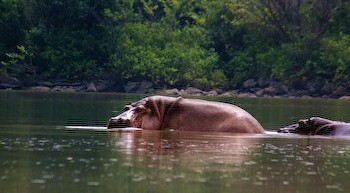|
Wechiau Community Hippo Sanctuary
The Wechiau community is
primarily inhabited by the Lobi people although the land belongs
to the Wala people and the Lobi compensate the Wala chief for
use of the land. Established in 1998, the sanctuary is
designated as a park and runs 40km long and 1.5km wide along
each bank of Ghana’s Black Volta River. It houses 17 villages,
10 schools and 2 health clinics. The Calgary Zoo became involved
in 1996. The Zoo performed a feasibility study which was
completed in 1998 and first tourist visitors arrived in 1999.
Community trust was built, among other things, through official
exchange visits between 3 Wechiau Chiefs and the CEO and the
President of the Calgary Zoo . Leadership exchanges began in
1999 and occur every 2 to 3 years. The project has been
financially self-sufficient since 2005. The project was awarded
a 2008 Equator Initiative prize.
 The location is remote and access roads are in poor
condition; journey by road to Ghana’s capital, Accra, takes a
full day. Until the Sanctuary project began, there were no
schools in the community. There were also no opportunities for
gainful employment and training in skills such as English is
hard due the lack of electricity so people can work in the day
and study at night. Approximately 10,000 people live within the
sanctuary. The location is remote and access roads are in poor
condition; journey by road to Ghana’s capital, Accra, takes a
full day. Until the Sanctuary project began, there were no
schools in the community. There were also no opportunities for
gainful employment and training in skills such as English is
hard due the lack of electricity so people can work in the day
and study at night. Approximately 10,000 people live within the
sanctuary.
Hippopotamus are an endangered species in Ghana. While they
were once numerous, the hippo population in Western Africa has
severely dwindled. One estimate cites the population of hippos
in West Africa is roughly 5% of total population of hippos in
Eastern and Southern Africa.
The sanctuary’s hippo population varies between 15 and 17
hippos. Hippos graze on land but spend most of their time in
water. While they are not carnivorous, they do attack those they
perceive as invading their territory. For humans this means that
fishermen’s boats are bumped around or knocked over and on land
they will exhibit hostile behavior. As a result, humans will
poach the hippos in order to eliminate the threat to their
livelihood (i.e. the use of the river for fishing and the land
for living). In addition, the Black Volta River is infected with
the guinea worm parasite making the water hazardous to humans.
 Villagers moved all farms and fishing camps two kilometers
away from the river. Since 2004, the Calgary Zoo has a staff
member living on-site year-round as a Sanctuary Advisor
providing technical support (to read Donna Sheppard’s updates
click here. Villagers moved all farms and fishing camps two kilometers
away from the river. Since 2004, the Calgary Zoo has a staff
member living on-site year-round as a Sanctuary Advisor
providing technical support (to read Donna Sheppard’s updates
click here.
Approximately a dozen full-time jobs have been created in the
Sanctuary. These jobs include: guides, park wardens, cooks and
maintenance staff. Improvements to the area include a village
and eco-tourism centre and 2 new primary schools. A high school
scholarship program was created with the first graduate in 2008.
As of November 2009, there are 15 high school scholars with an
additional 5 on waiting list, water boreholes have been built in
each of the 17 communities. 546 solar lights have been installed
(over a 4 year period). 183 of the solar light recipient
families were surveyed and the primary benefit being reported is
education, specifically, the ability to study at night.
|